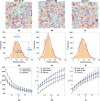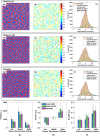Integrated Framework to Model Microstructure Evolution and Decipher the Microstructure-Property Relationship in Polymeric Porous Materials
- PMID: 39009042
- PMCID: PMC11284750
- DOI: 10.1021/acsami.4c03011
Integrated Framework to Model Microstructure Evolution and Decipher the Microstructure-Property Relationship in Polymeric Porous Materials
Abstract
Unraveling the microstructure-property relationship is crucial for improving material performance and advancing the design of next-generation structural and functional materials. However, this is inherently challenging because it requires both the comprehensive quantification of microstructural features and the accurate assessment of corresponding properties. To meet these requirements, we developed an efficient and comprehensive integrated modeling framework, using polymeric porous materials as a representative model system. Our framework generates microstructures using a physics-based phase-field model, characterizes them using various average and localized microstructural features, and evaluates microstructure-aware properties, such as effective diffusivity, using an efficient Fourier-based perturbation numerical scheme. Additionally, the framework incorporates machine learning methods to decipher the intricate microstructure-property relationships. Our findings indicate that the connectivity of phase channels is the most critical microstructural descriptor for determining effective diffusivity, followed by the domain shape represented by curvature distribution, while the domain size has a minor impact. This comprehensive approach offers a novel framework for assessing microstructure-property relationships in polymer-based porous materials, paving the way for the development of advanced materials for diverse applications.
Keywords: dynamic polymerization kinetics; microstructure−property relationship; phase separation; polymeric porous materials; spinodal decomposition.
Conflict of interest statement
The authors declare no competing financial interest.
Figures












References
-
- Alberti G.; Casciola M. Composite Membranes for Medium-Temperature PEM Fuel Cells. Annu. Rev. Mater. Res. 2003, 33 (1), 129–154. 10.1146/annurev.matsci.33.022702.154702. - DOI
-
- Guy D.; Lestriez B.; Guyomard D. New Composite Electrode Architecture and Improved Battery Performance from the Smart Use of Polymers and Their Properties. Adv. Mater. 2004, 16 (6), 553–557. 10.1002/adma.200306075. - DOI
LinkOut - more resources
Full Text Sources

